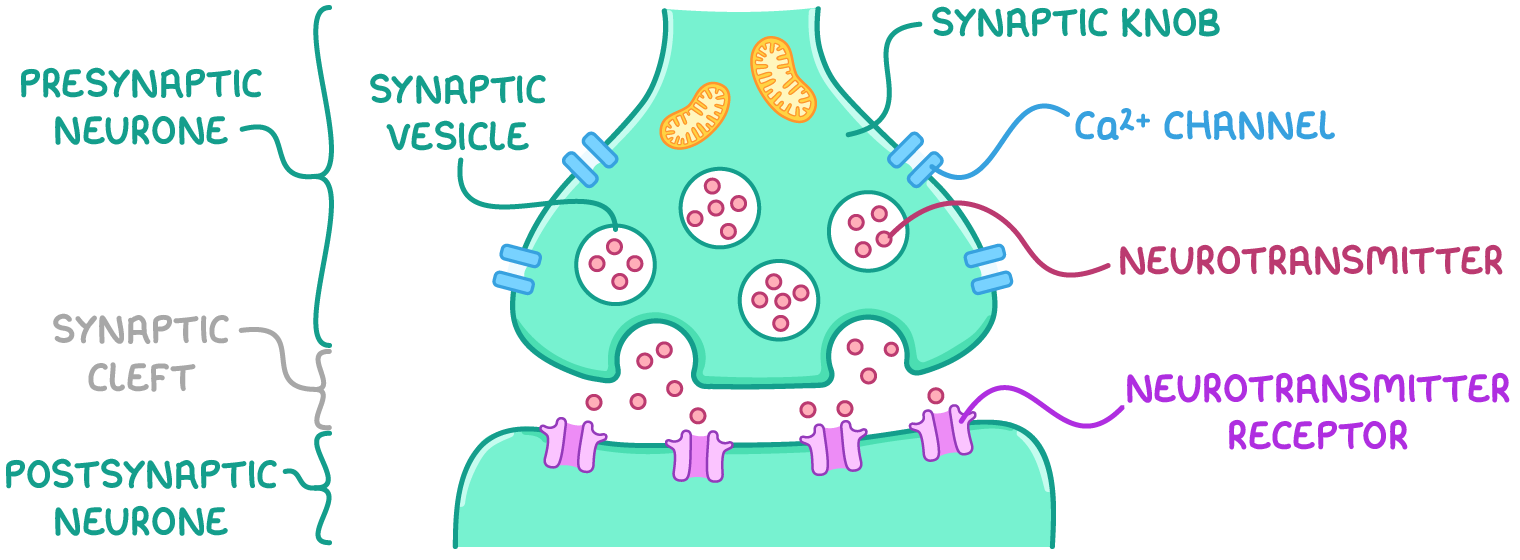Structure and Function of Synapses
This lesson covers:
- The functions of synapses
- The structure of synapses
- Excitatory and inhibitory synapses
- Spatial and temporal summation at synapses
The functions of synapses
A synapse is a junction where information is transferred from one neurone to another neurone or to an effector cell. Synapses are designed to allow transmission in only one direction: from presynaptic neurones to postsynaptic neurones or effector cells.
Synapses play several key roles in neural communication:
- They transmit information through the release of neurotransmitter chemicals.
- A single impulse from a presynaptic neurone can initiate impulses in multiple postsynaptic neurones or effector cells.
- Impulses from several presynaptic neurones can be combined into a single postsynaptic response.
The structure of synapses
Synapses are crucial for connecting neurones and coordinating activities in the nervous system.

The key structures in a synapse include:
- Presynaptic neurone - This neurone releases neurotransmitters into the synapse.
- Synaptic knob - The section at the end of the presynaptic neurone that contains the organelles needed for neurotransmitter production, like mitochondria to release energy.
- Synaptic vesicles - These sacs within the synaptic knob store neurotransmitters until they are released.
- Synaptic cleft - The gap between the presynaptic and postsynaptic neurones' membranes.
- Postsynaptic neurone - This neurone receives the neurotransmitters and can generate new action potentials.
- Neurotransmitter receptors - These specific molecules on the postsynaptic membrane bind with the neurotransmitters.
Excitatory and inhibitory synapses
The same neurotransmitter can have different effects on postsynaptic neurones depending on whether the neurotransmitter is excitatory or inhibitory at a particular synapse.
| Type of neurotransmitter | Effect on the postsynaptic membrane | Do they generate an action potential? | Examples |
|---|---|---|---|
| Excitatory | Depolarisation | May trigger an action potential if the threshold potential is reached | Acetylcholine is an excitatory neurotransmitter in the central nervous system and at neuromuscular junctions |
| Inhibitory | Hyperpolarisation | Prevent action potentials | Acetylcholine is an inhibitory neurotransmitter at cardiac synapses |
The steps involved in inhibitory synaptic transmission are:
- Inhibitory neurotransmitters are released into the synaptic cleft.
- Inhibitory neurotransmitters bind to chloride (Cl-) channels on the postsynaptic membrane.
- The opening of these channels allows an influx of Cl- into the postsynaptic neurone via facilitated diffusion.
- Potassium (K+) channels also open, and K+ leaves the postsynaptic neurone.
- This results in the hyperpolarisation of the postsynaptic membrane, preventing the generation of an action potential.
Spatial and temporal summation at synapses
If a synapse is weakly stimulated, it might not release enough neurotransmitter to reach the threshold necessary for an action potential to be generated in the postsynaptic neurone or effector cell. Summation is a process that combines these inputs to make the generation of an action potential in a postsynaptic neurone or effector cell more likely.
There are two types of summation: spatial summation and temporal summation.
Spatial summation:
- Multiple presynaptic neurones converge on a single postsynaptic neurone or effector cell.
- The combined input of neurotransmitters can trigger postsynaptic firing.
- Inhibitory inputs have the potential to prevent this firing.
Temporal summation:
- Repeated firing by a presynaptic neurone leads to continuous neurotransmitter release.
- An increased amount of neurotransmitter makes it more likely to trigger postsynaptic firing.